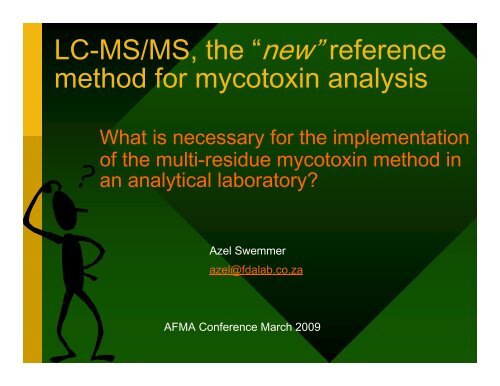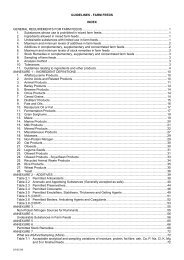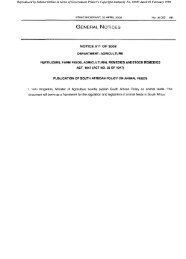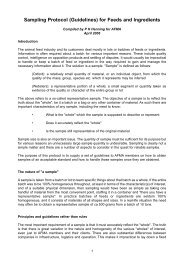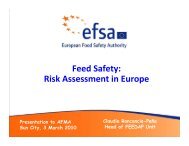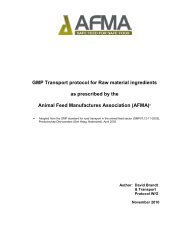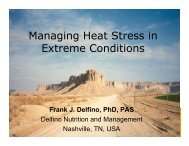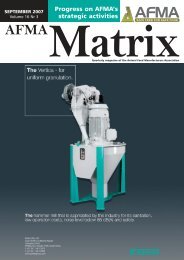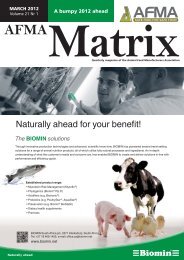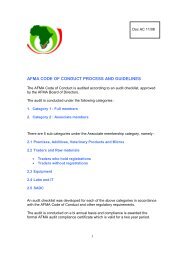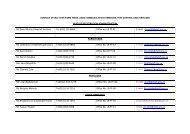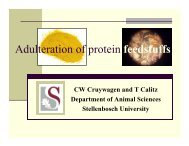8. Ms Azel Swemmer - LC-MSMS, the new reference method ... - AFMA
8. Ms Azel Swemmer - LC-MSMS, the new reference method ... - AFMA
8. Ms Azel Swemmer - LC-MSMS, the new reference method ... - AFMA
Create successful ePaper yourself
Turn your PDF publications into a flip-book with our unique Google optimized e-Paper software.
<strong>LC</strong>-MS/MS, <strong>the</strong> “<strong>new</strong>” <strong>reference</strong><br />
<strong>method</strong> for mycotoxin analysis<br />
What is necessary for <strong>the</strong> implementation<br />
of <strong>the</strong> multi-residue mycotoxin <strong>method</strong> in<br />
an analytical laboratory?<br />
<strong>Azel</strong> <strong>Swemmer</strong><br />
azel@fdalab.co.za<br />
<strong>AFMA</strong> Conference March 2009
Introduction<br />
Aspects that will be covered:<br />
• Analytical processes<br />
• Requirements for ISO 17025<br />
accreditation<br />
– Manpower, equipment, techniques<br />
and QA<br />
• Detection, quantification of trace level<br />
analytes
ANALYTICAL PROCESS<br />
Sampling<br />
Certificate of<br />
Analysis<br />
Data Manipulation<br />
Sample Submission<br />
Sample Extraction/<br />
Clean-up<br />
Instrumentation
Management<br />
requirements<br />
(section 4)<br />
• ISO 9001:2008<br />
Accreditation<br />
ISO 17025 standard<br />
Method<br />
accreditation<br />
Large batches, routine<br />
matrices<br />
Technical<br />
requirements<br />
(section 5)<br />
Technique<br />
accreditation<br />
Small batches, non-routine<br />
matrices
Technical Requirements<br />
• Skilled manpower<br />
• Sensitive equipment<br />
And <strong>method</strong>ology<br />
• An appropriate QA<br />
system
ANALYTICAL PROCESS<br />
Sampling<br />
Certificate of<br />
Analysis<br />
Data Manipulation<br />
Sample Submission<br />
Sample Extraction/<br />
Clean-up<br />
Instrumentation
ANALYTICAL PROCESS<br />
Sampling<br />
Certificate of<br />
Analysis<br />
Data Manipulation<br />
Sample Submission<br />
Sample Extraction/<br />
Clean-up<br />
Instrumentation
Extraction and cleanup of <strong>the</strong><br />
samples<br />
• Most critical step in <strong>the</strong> analytical process –<br />
essential to control this step<br />
– Selection of;<br />
• Sub-sample size,<br />
• Extraction solvents - dependant on <strong>the</strong><br />
matrix<br />
• Cleanup step – liquid/liquid or SPE or no<br />
cleanup?<br />
• Concentration step to reach detection<br />
limits<br />
– How How can can we we control control this this step?<br />
step?
QA of <strong>the</strong> extraction step<br />
• Use of Certified Reference Materials<br />
(CRM)<br />
• Spiking of samples<br />
• QC samples in batch<br />
• Participation in proficiency testing<br />
schemes
SOP must clearly spell out <strong>the</strong><br />
parameters to control during<br />
sample extraction<br />
• Laboratory temperature<br />
• pH meter fluctuations<br />
• Centrifugation speed and time<br />
• Scale calibration<br />
• Auto-pipette calibration<br />
• Grade of solvents/reagents specified in <strong>the</strong><br />
<strong>method</strong>
ANALYTICAL PROCESS<br />
Sampling<br />
Certificate of<br />
Analysis<br />
Data Manipulation<br />
Sample Submission<br />
Sample Extraction/<br />
Clean-up<br />
Instrumentation
Sensitivity depends on instrumentation used<br />
Potential for<br />
interferences<br />
MS-MS<br />
<strong>LC</strong>/GC-MS<br />
HP<strong>LC</strong>-F<br />
HP<strong>LC</strong>-UV<br />
ELISA<br />
Microbiological<br />
Ability to<br />
discriminate<br />
(Price increase)
Comparison of different techniques<br />
Method Method Method Method of of of of Analysis<br />
Analysis Analysis Analysis<br />
Thin Thin Layer Layer Chromatography Chromatography (T<strong>LC</strong>)<br />
(T<strong>LC</strong>)<br />
Enzyme Enzyme Linked Linked Immunosorbant<br />
Assay Assay (ELISA)<br />
(ELISA)<br />
High High Performance Performance Liquid<br />
Liquid<br />
Chromatography Chromatography (HP<strong>LC</strong>)<br />
(HP<strong>LC</strong>)<br />
Gas Gas chromatography chromatography (GC (GC-MS) (GC<br />
MS)<br />
<strong>LC</strong> <strong>LC</strong>-MS/MS <strong>LC</strong> MS/MS<br />
Costs/ Costs/ Costs/ Costs/<br />
group/sample<br />
group/sample<br />
group/sample<br />
group/sample<br />
(Rand) (Rand) (Rand) (Rand)<br />
N=10 N=10 N=10 N=10 ---- 100 100 100 100<br />
350<br />
250<br />
550<br />
600<br />
1250<br />
Method Method Method Method characteristics<br />
characteristics<br />
characteristics<br />
characteristics<br />
High Sensitivity<br />
Costs per single<br />
group<br />
Costs per single<br />
group<br />
Selected groups e.g.<br />
Tricho<strong>the</strong>nescenes<br />
All groups
Mycotoxin Multi Residue Method<br />
• The first first multi multi-<strong>method</strong>s multi<br />
<strong>method</strong>s were published 1999 1999-2002 1999<br />
2002<br />
(Berger (Berger (Berger (Berger et et et et al., al., al., al., Razzazi----Fazeli Razzazi Razzazi Razzazi Fazeli Fazeli Fazeli et et et et al., al., al., al., Rundberget Rundberget Rundberget Rundberget et et et et al.,Spanjer al., al., al., Spanjer Spanjer Spanjer et et et et al. al. al. al.<br />
etc.) etc.) etc.) etc.)<br />
• At this time, time, <strong>LC</strong> <strong>LC</strong>-MS/MS <strong>LC</strong><br />
MS/MS was mainly a scientific approach and<br />
a a lot lot of of maintenance maintenance was was necessary necessary to to run run samples samples within within a<br />
a<br />
broad broad range range of of commodities<br />
commodities<br />
• Since <strong>the</strong> instruments getting more robust,<br />
<strong>LC</strong> <strong>LC</strong>-MS/MS <strong>LC</strong><br />
MS/MS MS/MS has has been been increasingly increasingly applied applied for for routine<br />
routine<br />
food food control.<br />
control.<br />
• Today, it seems that <strong>the</strong>y are fit for purpose !
Instrumentation – <strong>LC</strong> MS/MS<br />
Ion source<br />
Column oven<br />
Solvent delivery module MS/MS<br />
Auto sampler
Advantages of <strong>LC</strong>-MS/MS<br />
• Sensitive detection for not one; but<br />
numerous mycotoxins in a single<br />
analysis.<br />
• Does not require tedious and expensive<br />
sample preparation due to sensitive<br />
tandem mass spectrometer – Results in<br />
fast turn around time for client.<br />
• Currently <strong>the</strong> <strong>method</strong> of choice in<br />
analytical laboratories.
Time scale to perform a batch (12 – 24) of<br />
analyses<br />
Samples weighing – 1,5 hours<br />
Samples are extracted with an extraction solvent – 2 hours<br />
Samples are cleaned up on a SPE cartridge – 3 hours<br />
Injection into <strong>LC</strong>-MS/MS – 8 hours<br />
Data Analysis – 2 hour<br />
Report – 0.5 hour
<strong>LC</strong>-MS/MS Results.<br />
Blank samples<br />
A) B)<br />
Certified <strong>reference</strong><br />
material at 3.2<br />
ug/kg<br />
Blank feed sample (A) vs naturally contaminated deoxynivalenol wheat sample (B)
Quantitation of T2 and HT2<br />
R = 1.000<br />
A B<br />
R = 0.9973<br />
Figure 4: Typical Calibration Curves obtained for T2 Toxin (A) and HT2<br />
Toxin (B). All data is calculated against matrix based calibration curves
Analysis performed against<br />
certified <strong>reference</strong> material.<br />
Day 1<br />
Day 2<br />
Day 3<br />
Day 1<br />
Day 2<br />
Day 3<br />
Deoxynivalenol Deoxynivalenol (DON) (DON)<br />
(DON)<br />
Added<br />
amount<br />
(µg/Kg)<br />
265<br />
265<br />
265<br />
3.2<br />
3.2<br />
3.2<br />
Zearalenone<br />
Zearalenone<br />
Added<br />
amount<br />
(µg/Kg)<br />
Value<br />
obtained<br />
(µg/Kg)<br />
2.84<br />
2.92<br />
2.57<br />
Value<br />
obtained<br />
(µg/Kg)<br />
266.70<br />
29<strong>8.</strong>63<br />
255.49<br />
Day 1<br />
Day 2<br />
Day 3<br />
Day 1<br />
Day 2<br />
Day 3<br />
Aflatoxin B1<br />
B1<br />
Added<br />
amount<br />
(µg/Kg)<br />
19<br />
19<br />
19<br />
Aflatoxin B2<br />
B2<br />
Added<br />
amount<br />
(µg/Kg)<br />
2.3<br />
2.3<br />
2.3<br />
Value<br />
obtained<br />
(µg/Kg)<br />
33.37<br />
30.12<br />
2<strong>8.</strong>39<br />
Value<br />
obtained<br />
(µg/Kg)<br />
2.96<br />
2.39<br />
2.77
Conclusions<br />
• Man-power must be skilled (VERY hard<br />
to find in SA)<br />
• Equipment is expensive<br />
• Technique accreditation – most difficult<br />
• QA requirements is laborious and difficult<br />
to control
ANALYTICAL PROCESS<br />
Sampling<br />
Certificate of<br />
Analysis<br />
Data Manipulation<br />
Sample Submission<br />
Sample Extraction/<br />
Clean-up<br />
Instrumentation
This is our policy to resolve<br />
complaints


